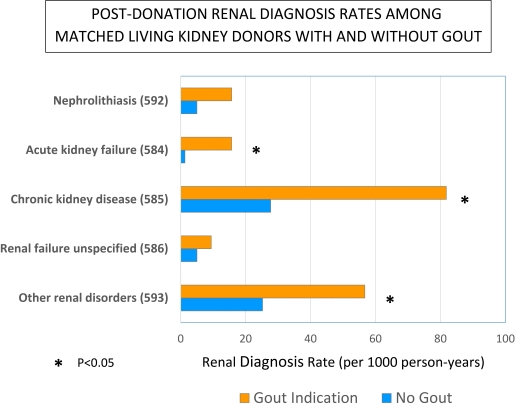Correlates and Consequences of Gout Among Living Kidney Donors
N. Lam,1 A. Garg,1 D. Segev,2 M. Schnitzler,3 H. Xiao,3 D. Axelrod,4 J. Tuttle-Newhall,3 D. Brennan,5 B. Kasiske,6 K. Lentine.3
1Western Uni., London, Canada
2John Hopkins Uni., Baltimore
3Saint Louis Uni., St. Louis
4Dartmouth Hitchcock Medical Center, Hanover
5Washington Uni., St. Louis
6Uni. of Minnesota, Minneapolis.
Meeting: 2015 American Transplant Congress
Abstract number: B182
Keywords: African-American, Donation, Metabolic disease, Renal dysfunction
Session Information
Session Name: Poster Session B: Living Donor Issues 1
Session Type: Poster Session
Date: Sunday, May 3, 2015
Session Time: 5:30pm-6:30pm
 Presentation Time: 5:30pm-6:30pm
Presentation Time: 5:30pm-6:30pm
Location: Exhibit Hall E
Background: Currently, the demographic correlates and consequences of gout in living kidney donors are understudied.
Methods: We examined a novel database that linked national U.S. identifiers of living kidney donors (1987-2007) to billing claims from a private health insurer (2000-2007 claims) to identify post-donation gout, defined as a composite of medical billing claims for a diagnosis of gout or pharmacy fill claims for a medication typically used to treat gout. Cox regression with left- and right-censoring was used to estimate the frequencies and risks of post-donation gout according to race. We also compared renal diagnosis rates as indicated by diagnostic codes among donors with and without gout, matched 1:3 by age, sex, and race.
Results: Among 4,650 donors, 76.3% were Caucasian, 13.1% were African-American, and 45% were men. By seven years post-donation, with age and sex adjustment, African-Americans were almost twice as likely to develop gout as Caucasian donors (4.4% vs. 2.4%; adjusted hazard ratio, aHR, 1.8; 95% confidence interval, CI, 1.0 to 3.2; P=0.04). The risk of post-donation gout also increased with older age at donation (aHR per year 1.05) and was higher in male donors (aHR 2.80). Donors with gout had more frequent post-donation renal diagnoses compared to matched donors without gout, reaching significance for acute kidney failure (rate ratio 12.5; 95% CI 1.5 to 107.0), chronic kidney disease (rate ratio 2.9; 95% CI 1.7 to 5.2), and other disorders of the kidney (rate ratio 2.2; 95% CI 1.2 to 4.2).

Conclusion: Donor subgroups at increased risk of post-donation gout include African-Americans, older donors, and men. Donors with gout have an increased burden of renal complications after demographic adjustment. Future studies should examine whether the attributable impact of donation on gout and related complications differs according to demographic characteristics.
To cite this abstract in AMA style:
Lam N, Garg A, Segev D, Schnitzler M, Xiao H, Axelrod D, Tuttle-Newhall J, Brennan D, Kasiske B, Lentine K. Correlates and Consequences of Gout Among Living Kidney Donors [abstract]. Am J Transplant. 2015; 15 (suppl 3). https://atcmeetingabstracts.com/abstract/correlates-and-consequences-of-gout-among-living-kidney-donors/. Accessed December 20, 2025.« Back to 2015 American Transplant Congress
